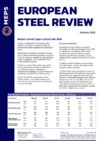European steel buyers seek direction in volatile market
Demand for steel is slow to recover, after the summer break. Mill production costs continue to increase. Steel purchasers are uncertain about the future direction of the market.
European steel buyers returned cautiously to the market, as the traditional summer break extended into early September. Inventory levels remain relatively high, for current demand. Sensing that the bottom of the current cycle had been reached, however, some purchasers placed orders for small quantities, to reduce their average stock value.
European steel prices continued to decline, last month. In late August and early September, the mills started to announce increases, in line with rising costs, across the carbon steel product range. These efforts were against the background of spiralling international energy values.
Major steel manufacturers led the way. Their efforts, initially, were undermined by certain producers seeking to fill their order books. Large, proposed increases were accompanied by a willingness to negotiate, or to extend the validity of previous prices, to their regular customers who had just returned from holiday. This eroded buyers’ confidence in the strength of such moves.
As order books weaken, steel mills are aligning production to apparent demand. Capacity cuts have been implemented, although perhaps not soon enough. Several blast furnaces have been taken offline, for extended periods. Rerollers are restricting production to night-time and weekend working, to control electricity consumption. As a consequence, delivery lead times are once again extending, rather than contracting.
Industry, as a whole, is looking to the authorities to address problems with energy supply and costs. The EU has announced measures to cap energy prices, partly funded by additional taxes on excess profits of energy providers. This should protect private consumers, to some extent. Policies show little detail for energy-intensive manufacturers. Some individual states have mandated a reduction in electricity usage.
In the UK, political decisions are delayed during the period of mourning for Her Late Majesty Queen Elizabeth II. A cap on domestic electricity costs has been announced. Further proposals, for industrial users, are reportedly in preparation.
The possibility of steelmakers implementing energy-related surcharges is again a topic of interest. Most market observers consider such a move to be impracticable for commodity grade steel. It is also extremely doubtful that producers who propose such a move would be willing to open their energy usage and supply contracts to the scrutiny such a clause would require.
Elevated energy costs are not isolated to primary steel producers. Oil, gas and electricity are used throughout the supply chain, resulting in incremental charges at each stage. Finally, it is the individual consumer who pays, or chooses not to. Escalating household energy costs and the subsequent drain on disposable income lead to reduced downstream steel demand. High inflation rates also restrict private expenditure.

Source:
European Steel Review
The MEPS European Steel Review is an informative, concise and easy-to-use monthly publication, offering unique professional insight into European carbon steel prices.
Go to productRequest a free publication





